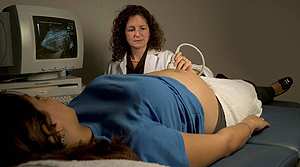February 14, 2011 - By Erin Digitale

Deirdre Lyell is directing a new program at Lucile Packard Children’s Hospital for treatment of placental disorders. While such conditions are rare, they can have dire consequences if not addressed.
The placenta is probably the most-ignored human organ — in most pregnancies, it does its job without fanfare until the baby arrives, then ends up in a bucket.
But for a small group of pregnant women who develop placental disorders, the organ is dangerous to ignore. In these rare cases, the placenta grows across the cervix, blocking the uterine opening, or attaches too deeply to the uterine wall. The consequences can include bleeding during pregnancy, restricted fetal growth, preterm labor and life-threatening maternal hemorrhage at delivery.
To address the problems faced by women with these types of pregnancies, Packard Children’s high-risk obstetrics team has inaugurated a new program for placental disorders in the hospital’s Johnson Center for Pregnancy and Newborn Services.
“These women require very complex care with multiple providers,” said Packard Children’s high-risk obstetrician Deirdre Lyell, MD, who directs the new program.
Assisting one patient safely through pregnancy and delivery can require input from practitioners in maternal-fetal medicine, gynecologic oncology, interventional radiology, vascular surgery, obstetric anesthesia, the blood bank, pediatric radiology and neonatal intensive care. The new program provides a streamlined process that ensures women and their babies will receive all the care they need, said Lyell, who is also an associate professor of obstetrics and gynecology at the School of Medicine said.
Lyell’s team treats the full range of placental abnormalities, including placenta previa, in which the placenta partly or completely covers the cervix; placenta accreta and placenta increta, in which the placenta grows too deeply into the uterine muscle; and placenta percreta, when the placenta grows all the way through the uterine wall, sometimes invading nearby organs such as the bladder. Center physicians also have ongoing research projects to investigate the causes of abnormal placentation.
The new program accepts patients with known or suspected placental disorders, including those with no diagnosis but with risk factors such as a history of uterine surgery. (The placenta is more likely to attach deeply in scar tissue.) All patients are scheduled for a confirmatory ultrasound and assessments with the multidisciplinary care team, followed by communication of the team’s findings back to the referring physician.
The program’s offerings range from consulting on patients who will deliver at their home hospitals to assuming all care if necessary.
“We focus on keeping women in their own communities for as long as is safe,” Lyell said. Standard care for patients includes pelvic rest, regular non-stress tests to check for contractions and administration of steroids to help mature the fetal lungs since placental disorders often require early delivery. Women can be hospitalized in the Packard Children’s antepartum unit if they show signs of trouble, such as repeated bleeding or preterm labor, or if they lack transportation to get to the hospital quickly as they near term.
For cases in which the probability of hemorrhage at delivery is high, the team schedules a combined cesarean-hysterectomy performed at Stanford Hospital by an obstetrician and a gynecologic oncologist experienced in complex uterine surgery. This option is often the best route to prevent significant blood loss. Both mother and baby benefit from the team’s coordinated care, since Packard Children’s neonatologists are present at the birth to receive the baby and move him or her to the NICU if needed.
“Streamlining care for these patients was really important and necessary,” Lyell said. “We’re excited about our new offerings.”
About Stanford Medicine
Stanford Medicine is an integrated academic health system comprising the Stanford School of Medicine and adult and pediatric health care delivery systems. Together, they harness the full potential of biomedicine through collaborative research, education and clinical care for patients. For more information, please visit med.stanford.edu.